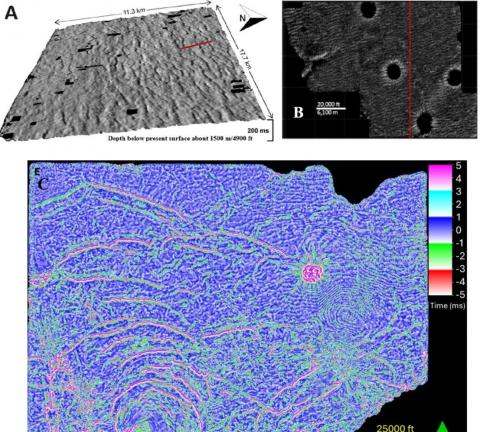KATC Meteorologist Jobie Lagrange visited Hamilton Hall to give a guest lecture about hurricanes for students in Int
Characteristics and Distribution of Chicxulub Impact Tsunami Megaripples on the northern Gulf of Mexico Paleo-shelf and Paleo-slope.
Tue, 02/04/2025 - 3:45pm
Using petroleum industry seismic data reflected from about 1500 m underground in central-northern Louisiana, Kinsland et al. (2021) imaged megaripples resulting from the 66 million year old Chicxulub Impact tsunami. Those megaripples resulted from the tsunami encountering the paleo-shelf break, shown as a change in color from blue of the deeper water to blue-grey of the paleo-shelf.
New research, Kinsland et al. (2025) images megaripples further up the shelf and over the shelf break on the paleo-slope.
Each of the separate areas is completely covered with tsunami megaripples, see images. The characteristics of the megaripples are different in the three images illustrating the interaction of the tsunami with the slope, the shelf break, and the low angle of the upper shelf. From the coverage of the three areas here in Louisiana we infer that the buried northern Gulf of Mexico shelf system, from Texas to Florida, is covered with megaripples from at least the paleo-slope up to the paleo-bathymetry where Gulf storms would have eroded the megaripples after their formation.
This study was conducted by Gary L. Kinsland as a Retired Emeritus Professor of Geosciences with Rui Zhang, geophysics professor and the collaboration of Fairfield Geotechnologies (Stephen Klug), Chesapeake Energy (Rika Burr), and Seismic Exchange Incorporated (Layne Williams).
